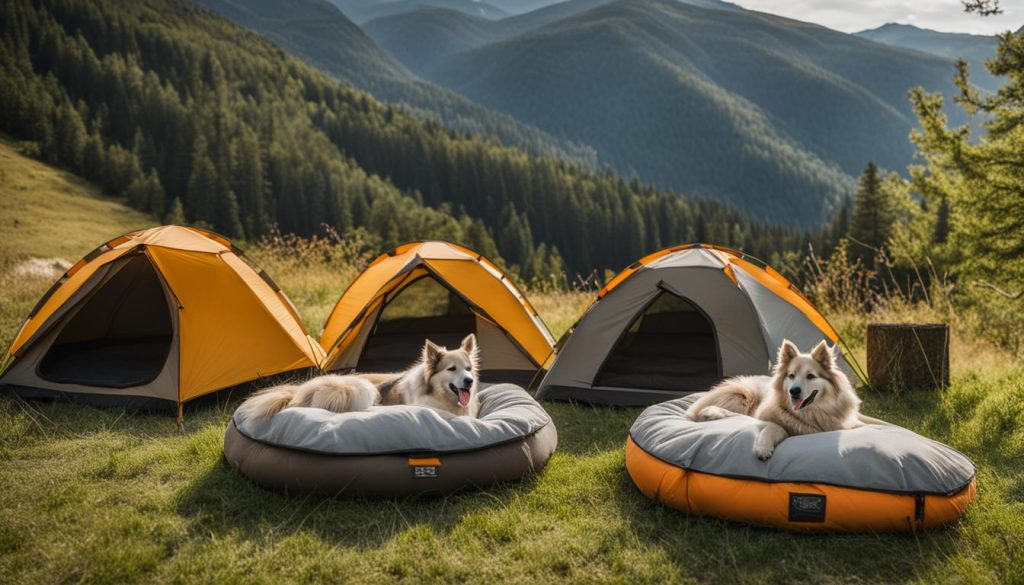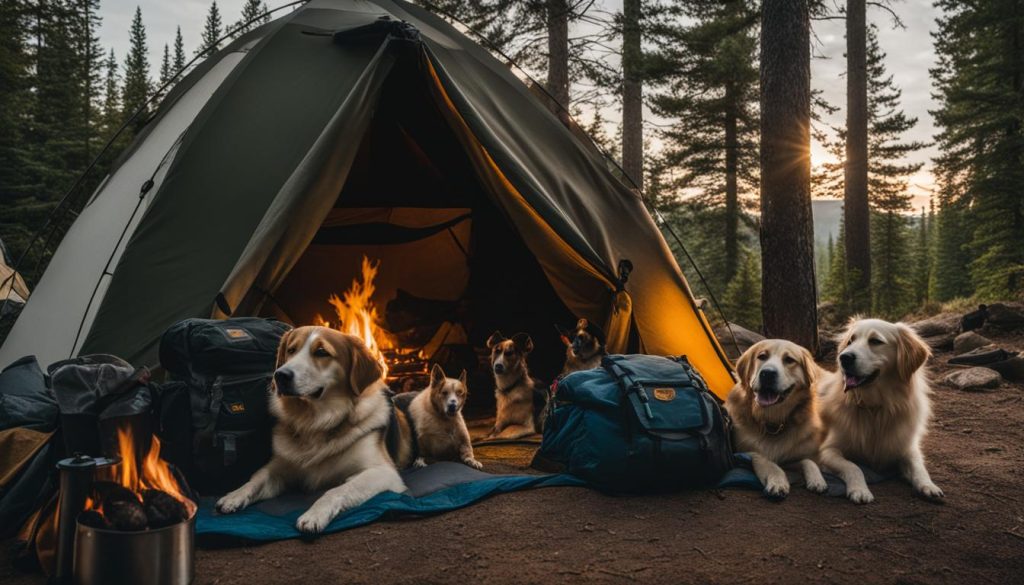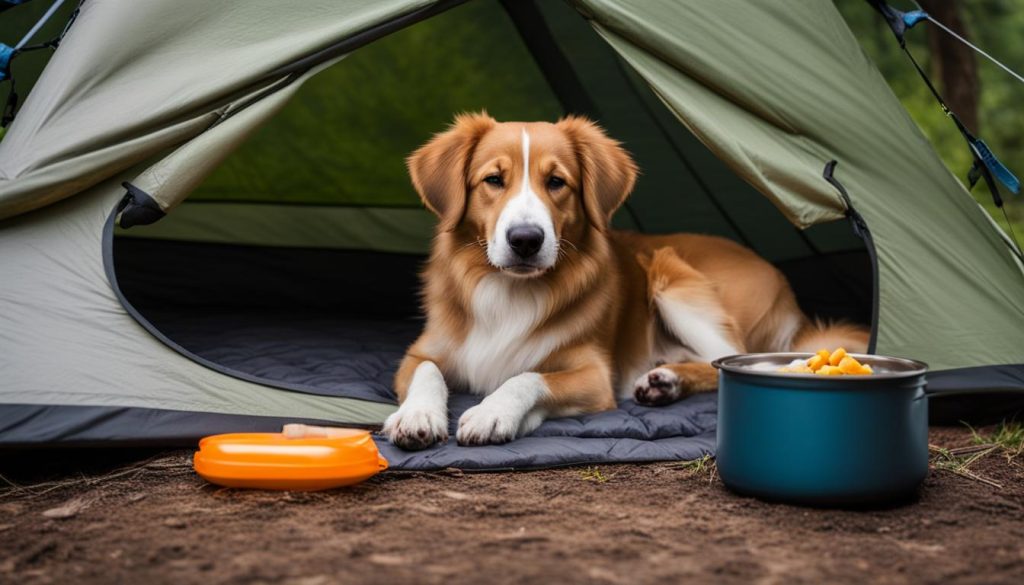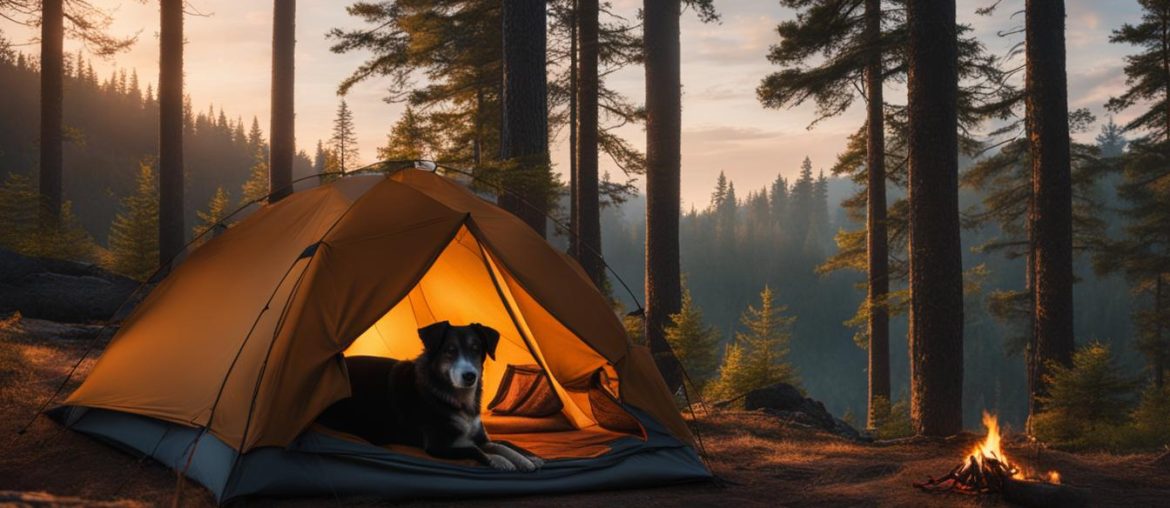Taking your dog camping is an exciting adventure, but ensure your dog has a comfortable and safe place to sleep. Dogs should sleep in the same shelter as humans, whether it’s a tent, RV, or under the stars. Providing a dog bed that is elevated and insulated from the ground is essential to keep your dog comfortable and protected from predators. Expert advice includes selecting a bed that is washable and has a tough, waterproof bottom.
Key Takeaways:
- Dogs should sleep in the same shelter as humans when camping.
- Provide an elevated and insulated dog bed to keep them comfortable and protected.
- Select a bed that is washable and has a tough, waterproof bottom.
- Consider the temperature and weather conditions when deciding where your dog should sleep.
- Respect campground rules and be considerate of other campers when camping with dogs.
Essential Dog Camping Gear: Bed, Collar, and Leash
When it comes to camping with dogs, I would advise that you have the right gear to ensure their comfort and safety. Here are some must-have items for a successful dog camping trip:
Dog Bed:
A comfortable and insulated dog bed is essential for your furry friend’s sleep arrangements. Dogs shouldn’t sleep directly on the ground as it can be uncomfortable and dangerous. Look for a bed that is elevated and insulated from the ground, providing a cozy and secure space for your dog to rest. It’s also important to choose a bed that is washable and has a tough, waterproof bottom to withstand the elements.
Collar and Leash:
Having an updated collar and leash for your dog is crucial when camping. A sturdy collar with identification tags is important for easy identification in case your dog gets lost. It’s also important to have a reliable leash to keep your dog safely restrained during camping trips. Opt for a leash that is strong and durable, yet comfortable for both you and your dog.
Tie Lines:
In most parks and campgrounds, dogs must be on a leash or tied to a line. A tie line, also known as a tie out, is a leash specifically designed for use at a campsite. It allows your dog to have some freedom of movement while still being securely restrained. When choosing a tie line, make sure it is weather-resistant and strong enough to anchor your dog safely.
With the right gear, you can ensure that your dog is comfortable, secure, and ready for a fantastic camping adventure.

Stay Visible and Safe: Reflective Gear for Dogs
When camping with dogs, prioritize their safety and visibility, especially in low light conditions or at night. This is where reflective gear comes in. Reflective gear, such as a reflector harness or light-up collar, can greatly enhance your dog’s visibility to people and vehicles, reducing the risk of accidents or getting lost.
When choosing reflective gear for your dog, consider their specific needs. Take into account factors like hair length and visibility. For dogs with longer hair, a light-up collar or a reflective bandana can be more effective in ensuring visibility. On the other hand, dogs with shorter hair may benefit from a reflective harness that covers a larger area of their body.
Reflective gear should be worn by your dog during all outdoor activities, including sleeping in tents. This ensures that they are easily visible to other campers, minimizing any potential risks or misunderstandings. Prioritize their safety by investing in high-quality reflective gear that is durable and comfortable for your dog to wear. Try to test the reflective properties before heading out to ensure maximum visibility.

Table: Types of Reflective Gear for Dogs
| Type | Description |
|---|---|
| Light-up Collar | A collar with integrated LED lights that can be set to steady or flashing mode for increased visibility. |
| Reflector Harness | A harness with reflective stripes or patches that cover a larger area of the dog’s body, providing enhanced visibility. |
| Reflective Bandana | A bandana made of reflective material that can be easily tied around the dog’s neck for added visibility. |
| Reflective Vest | A vest with reflective panels that can be worn over your dog’s regular harness or collar, increasing visibility from various angles. |
To put it simply, reflective gear is not only essential for your dog’s safety but also for your peace of mind. By ensuring that your dog is easily visible, you can both enjoy your camping experience with confidence and without worry.
Keep Your Dog Secure: Tie Lines and Leashes
When camping with dogs, it is good practice to keep them secure and ensure their safety. This involves using tie lines and leashes to restrain your dog and prevent them from wandering off or getting into potentially dangerous situations. Dogs must always be on a leash or tied to a line in most parks and campgrounds, as this helps maintain a peaceful coexistence with other campers and protects the local wildlife and environment.
The Role of Tie Lines
Tie lines, also known as tie-outs, are specifically designed leashes for use at campsites. They are typically made of durable materials that can withstand outdoor elements and securely anchor your dog to a fixed point. Tie lines give your dog the freedom to move around within a designated area while still keeping them safely restrained. You can attach the tie line to a tree, a stake in the ground, or another stable object.
Choosing the Right Tie Line
When selecting a tie line for your dog, you should consider its strength and durability. Look for a tie line that is weather-resistant and made from sturdy materials that can withstand pulling and tugging. Ensure that the tie line is long enough to give your dog adequate space to move around but not too long that they can wander off into restricted areas. It is also essential to regularly inspect the tie line for any signs of wear and tear.
The Importance of Leashes
Leashes are another essential tool for keeping your dog secure during camping trips. Unlike tie lines, leashes are used for walks and hikes, providing flexibility and control in various terrains. A sturdy leash ensures that you have a firm grip on your dog and can prevent them from running off or getting lost. You should choose a leash that is long enough to give your dog some freedom of movement while still remaining under your control.
“Tie lines and leashes are vital for the safety and security of your dog when camping. They prevent them from wandering off, protect the local wildlife, and ensure a peaceful camping experience for everyone.”
Try to always keep your dog on a leash or tied to a line, following the rules and regulations of the campsite you are staying at. This not only promotes a safe environment but also shows respect for other campers and the surrounding nature. By utilizing tie lines and leashes, you can have peace of mind knowing that your beloved canine companion is secure and protected throughout your camping adventure.
| Tie Line | Leash |
|---|---|
| Designed for use at campsites | Used for walks and hikes |
| Serves as a secure anchor for your dog | Provides flexibility and control |
| Keeps your dog within a designated area | Allows for freedom of movement |
| Should be made of durable materials | Should be sturdy and reliable |
Image source: seo-writing.ai
Food and Water Essentials for Dogs When Camping
When camping with your furry companion, please ensure they have access to food and water. Just like humans, dogs need nourishment and hydration to stay healthy and energized during outdoor adventures. Here are some essential food and water essentials to consider when camping with dogs:
- Dog Food: Pack enough dog food for the duration of your camping trip, taking into account your dog’s size, age, and dietary needs. It’s best to bring the same brand and type of food your dog is accustomed to, as sudden dietary changes can cause digestive issues. Store the food in a sealed container to keep it fresh and prevent wildlife from being attracted to the scent.
- Water: Dogs need access to clean and fresh water at all times, especially when engaging in physical activities. Bring a separate water bowl for your dog and ensure it is filled regularly. Consider bringing a water filtration system if you’re camping in an area without easily accessible clean water sources. This will ensure that your dog stays properly hydrated throughout the trip.
In addition to providing food and water, clean up after your dog to maintain cleanliness and avoid attracting wildlife. Always dispose of waste properly and follow Leave No Trace principles. Bringing biodegradable waste bags makes cleaning up messes quick and easy.
“Proper food and water provision is essential for your dog’s overall well-being while camping. By ensuring they have access to their regular food and ample clean water, you’re providing them with the necessary nutrition and hydration to enjoy the camping experience alongside you.”
Try to monitor your dog’s food and water intake to prevent overeating or dehydration. Be mindful of the weather conditions as well. In hot weather, provide shade and access to cool water to prevent heatstroke, while in cold weather, consider bringing a thermos with warm water to keep your dog’s body temperature regulated.
Table: Dog Camping Food and Water Essentials
| Essentials | Description |
|---|---|
| Dog food | Bring enough dog food for the entire camping trip, taking into account your dog’s size and dietary needs. Store it in a sealed container to keep it fresh. |
| Water | Provide clean and fresh water for your dog at all times. Consider bringing a water filtration system if necessary. |
| Water bowl | Bring a separate water bowl for your dog to ensure they have a constant supply of water. |
| Waste bags | Bring biodegradable waste bags to clean up after your dog and dispose of waste properly. |

By prioritizing your dog’s food and water needs while camping, you can ensure that they stay healthy, happy, and energized throughout the adventure. Providing them with familiar and nutritious meals, access to clean water, and practicing proper waste management will contribute to a positive camping experience for both you and your furry friend.
Weather Protection for Dogs: Jackets and Cooling Buffs
When camping with dogs, please protect them from extreme weather conditions. Dogs can be sensitive to temperature changes, so provide them with the right gear to keep them comfortable and safe.
In colder weather, lightweight and water-resistant dog jackets are recommended. These jackets provide insulation and help retain body heat, keeping your dog warm and cozy. I recommend that you choose a jacket that fits properly and allows for freedom of movement. Look for jackets with adjustable straps and reflective elements for added safety during nighttime walks.
In hotter temperatures, cooling buffs can help regulate your dog’s body temperature. These innovative accessories are made from a moisture-wicking fabric that cools when wet and evaporates slowly to provide lasting comfort. Simply soak the buff in water and place it on your dog’s neck or head to help them stay cool during outdoor activities.
not all dogs will tolerate wearing jackets or buffs, so I would advise that you observe your dog’s behavior and remove the gear if they show signs of discomfort or distress. Additionally, avoid sweaters and fabrics that can absorb dirt and smells, as this can be unpleasant for both you and your furry friend.

Essential Gear for Weather Protection
| Gear | Description |
|---|---|
| Dog Jackets | Lightweight and water-resistant jackets that provide insulation and warmth in colder weather. Look for adjustable straps and reflective elements for safety. |
| Cooling Buffs | Moisture-wicking fabric buffs that help regulate body temperature in hotter temperatures. Soak in water and place on the neck or head for cooling effect. |
| Proper Fit | Ensure jackets and buffs fit properly and allow for freedom of movement. Avoid tight-fitting or restrictive gear that can cause discomfort. |
| Observation | Observe your dog’s behavior and remove the gear if they show signs of discomfort or distress. Not all dogs will tolerate wearing jackets or buffs. |
Camping with Dogs: Paw Care Essentials
When you take your furry friend camping, remember that their paws need special care. Dogs’ paws can get dirty, wet, and even injured while exploring the great outdoors. To ensure their comfort and safety, consider investing in towels and booties specifically designed for dog camping.
Protecting Paws with Towels
Having a designated towel to wipe your dog’s paws can help keep them clean and dry during your camping adventures. Look for quick-dry towels that are lightweight and resistant to dirt. These towels are not only practical but also easy to pack and carry. Whenever your dog returns from a walk or hike, simply use the towel to wipe off any dirt or moisture, keeping their paws clean and comfortable.
Ensuring Paw Safety with Booties
Booties can provide an extra layer of protection for your dog’s paws while camping. They can help shield their paws from hot or cold ground, rough terrain, sharp objects, and even muddy conditions. When selecting booties, choose ones that are durable, lightweight, and easy to put on. Properly fitted booties will stay securely in place, allowing your dog to walk and play with ease. Keep in mind that some dogs may require time to get used to wearing booties, so it’s a good idea to gradually introduce them before your camping trip.

The Benefits of Paw Care
Paying attention to your dog’s paw care can bring several benefits. By wiping their paws after outdoor activities, you can prevent dirt and debris from being tracked into your camping shelter, keeping it clean and comfortable for both of you. Booties can provide protection against rough or hot surfaces, reducing the risk of paw pad injuries. Additionally, paw care can also help prevent the skin on your dog’s paws from drying out or cracking, especially in harsh weather conditions. Overall, prioritizing paw care is a simple yet effective way to ensure your dog’s comfort and well-being during your camping trips.
Tips for Camping with Dogs: Health Check-ups and Vaccinations
Before embarking on a camping trip with your dog, please prioritize their health and well-being. Taking your furry friend for a thorough health check-up is essential to ensure they are fit for outdoor adventures. During the check-up, make sure your dog is up to date on all vaccinations and parasite control measures. This will help protect them from potential diseases and parasites they may encounter while camping.
Regular visits to the vet are important not only for vaccinations but also for addressing any known health conditions. Your vet can provide guidance on specific health precautions to take while camping, such as protecting against ticks, fleas, and other common outdoor pests. This will help ensure your dog stays safe and healthy throughout your camping trip.
In addition to vaccinations and parasite control, don’t forget to bring your dog’s medical records with you. Having these documents on hand can be helpful if you need to visit a local vet during your camping trip or when crossing state lines.
| Health Check-up Checklist | Vaccination Status | Parasite Control |
|---|---|---|
| Schedule a vet appointment before the camping trip | Ensure all vaccinations are up to date | Administer flea and tick prevention medication |
| Discuss camping plans with the vet | Consider additional vaccinations based on the camping destination | Provide heartworm prevention medication if necessary |
| Bring copies of medical records | Keep records accessible during the camping trip | Ensure deworming is up to date |
By prioritizing your dog’s health and taking necessary precautions, you can enjoy a worry-free camping experience with your four-legged companion.
Know the Campsite Rules for Dogs
When planning a camping trip with your furry companion, please familiarize yourself with the campsite rules and regulations regarding dogs. The last thing you want is to arrive at your destination only to find out that your dog is not allowed or there are specific restrictions you were unaware of. By knowing the campsite rules in advance, you can ensure a smooth and enjoyable camping experience for both you and your dog.
Different campsites have varying policies when it comes to pets. Some may have breed restrictions, limit the number of dogs allowed per campsite, or require dogs to be kept on a leash at all times. You should also research and understand these rules before making a reservation to avoid any surprises or potential conflicts during your stay.
Furthermore, find a comfortable camping spot for your dog. Look for areas with ample shade, away from high traffic areas or hazardous terrain. Providing a cozy and secure space for your dog to sleep will contribute to their overall comfort and well-being while camping.
In summary, being aware of the campsite rules for dogs is crucial when planning a camping trip. Knowing the restrictions and regulations allows you to make informed decisions and avoid any potential issues. By selecting a campsite that accommodates dogs and following the rules in place, you can ensure a safe and enjoyable outdoor experience for both you and your furry friend.

Table: Campsite Rules for Dogs
| Campsite | Number of Dogs Allowed | Breed Restrictions | Leash Policy |
|---|---|---|---|
| Wilderness Campground | 2 | No restrictions | Dogs must be kept on a leash at all times |
| Lakefront RV Park | 1 | No Pit Bulls or Pit Bull mixes | Dogs must be kept on a leash at all times |
| Mountain Retreat | 3 | No restrictions | Dogs must be kept on a leash in common areas |
Consider Your Dog’s Comfort and Safety
When camping with your furry friend, please prioritize their comfort and safety to ensure a pleasant experience for both of you. Here are some tips to help create a safe and cozy space for your dog to sleep:
1. Bring Your Dog’s Bed from Home
To provide your dog with a familiar sleeping environment, bring their own bed from home. This will help them feel more secure and comfortable during the camping trip. Place their bed in a quiet corner of your tent or camping area, away from any potential hazards.
2. Consider the Temperature and Weather
Before deciding whether your dog should sleep inside or outside the tent, consider the temperature and weather conditions. If it’s chilly, your dog may prefer to sleep inside the tent for extra warmth. On the other hand, if it’s hot, it might be more comfortable for them to sleep outside the tent where there is better airflow.
3. Create a Safe and Cozy Space
Set up a designated area for your dog to sleep, ensuring it is safe and cozy. Use a pet-friendly sleeping pad or blanket to provide extra cushioning and insulation from the ground. Consider using a portable dog crate or playpen to create a secure space for your dog to sleep if they tend to wander or if it helps them feel more at ease.

4. Check for Potential Hazards
Before settling in for the night, thoroughly inspect the area for any potential hazards that could harm your dog. Remove sharp objects, toxic plants, or anything they could chew on and potentially swallow. Keep an eye out for nearby bodies of water, campfire pits, or other elements that could pose a risk to your dog’s safety.
By considering your dog’s comfort and safety, you can ensure they have a restful night’s sleep while camping. Try to always supervise your dog and watch out for any signs of discomfort or distress. With proper planning and preparation, camping with your dog can be a memorable and enjoyable experience.
Be Mindful and Respectful of Others When Camping with Dogs
When camping with dogs, I would advise that you be considerate of fellow campers and follow proper campground etiquette. This ensures a harmonious and enjoyable experience for everyone involved. Here are some important tips to keep in mind:
Keep Your Dog Leashed
One of the most crucial rules of camping with dogs is to keep them leashed at all times, unless in designated off-leash areas. This not only ensures the safety of your dog but also prevents any potential conflicts with other campers or wildlife. Try to use a sturdy leash and avoid extending it too far, so you can maintain control over your dog.
Respect Quiet Hours
Many campgrounds have designated quiet hours during which campers are expected to keep noise to a minimum. I recommend that you be mindful of these hours and prevent excessive barking or noise from disturbing fellow campers. By respecting quiet hours, you show consideration and create a peaceful atmosphere for everyone to enjoy.
Clean up After Your Dog
Proper waste management is an essential part of responsible camping with dogs. Always carry waste bags with you and promptly clean up after your dog, disposing of waste in designated trash cans. This helps maintain the cleanliness of the campground and prevents the spread of bacteria or unpleasant odors.
Be Mindful of Others’ Comfort
Not everyone may be comfortable around dogs, so be considerate of others’ fears or allergies. Keep your dog away from other campers’ tents or campsites, and avoid allowing your dog to approach or jump on strangers without their permission. Respecting personal boundaries ensures a positive and inclusive camping experience for all.
By adhering to these guidelines and maintaining respectful behavior, you can ensure a pleasant camping experience for both yourself and your furry friend. To put it simply, being considerate of others and their camping experience is key to fostering a welcoming and harmonious environment.

Final Thoughts
Camping with dogs can be a wonderful experience for both you and your furry friend. By following the expert tips and insights in this article, you can ensure that your dog has a safe and comfortable sleeping arrangement while camping. From providing a cozy bed to choosing the right gear for various weather conditions, prioritizing your dog’s needs will make your camping trip enjoyable for everyone.
Try to be mindful of campground rules and respectful of other campers to create a positive camping experience with your dog. This includes keeping your dog leashed, respecting quiet hours, and cleaning up after your dog. By choosing a comfortable camping spot for your dog to sleep, such as inside or outside the tent, you can ensure their safety and well-being throughout the trip.
Whether you’re sleeping in a tent or RV, consider your dog’s comfort and safety. Bring along their own bed from home to provide them with a familiar sleeping environment. Additionally, be prepared for different weather conditions by packing jackets or cooling buffs to keep your dog comfortable in various temperatures. By following these tips and being a responsible dog owner, you can create lasting memories while camping with your beloved pup.
FAQ
Where should dogs sleep when camping?
Dogs should sleep in the same shelter as humans, whether it’s a tent, RV, or under the stars.
Why is it important to provide a comfortable and insulated dog bed for camping?
Dogs shouldn’t sleep directly on the ground as it can be uncomfortable and dangerous. An elevated and insulated dog bed keeps them comfortable and protected from predators.
What features should I look for in a dog bed for camping?
Select a bed that is washable, has a tough and waterproof bottom, and is elevated and insulated from the ground.
What are the essential items for camping with dogs?
Apart from a comfortable dog bed, essential items include an updated collar and tags, a sturdy leash and tie line, and reflective gear for visibility.
Why is it important to keep dogs visible and safe while camping?
Reflective gear, such as reflector harnesses or light-up collars, helps ensure that your dog is visible to people and vehicles, especially at night or in low light conditions.
What’s the difference between a tie line and a leash for camping?
A tie line is specifically designed for use at a campsite to securely anchor your dog, while a leash is used for walks and hikes, providing flexibility and control.
Why is it important to bring separate bowls for water and food when camping with dogs?
Bringing separate bowls ensures that your dog has a constant supply of clean water and avoids contamination. It’s also important to clean up after each meal to prevent attracting unwanted wildlife.
How can I protect my dog from temperature changes while camping?
Depending on the weather conditions, you can provide your dog with appropriate clothing such as lightweight, water-resistant jackets for colder weather or cooling buffs for hot temperatures.
How do I keep my dog’s paws clean and protected while camping?
Having a designated towel to wipe their paws and using booties can help keep your dog’s paws clean and protected from hot or cold ground, rough terrain, and mud.
Why is a health check-up important before going camping with your dog?
A health check-up ensures that your dog is up to date on vaccinations and parasite control measures and is in good health before going on an outdoor adventure.
What should I know about campsite rules for dogs?
I recommend that you research and understand the campsite’s policies regarding pets, including the number of pets allowed, any breed restrictions, and designated pet areas within the campsite.
How can I ensure my dog’s comfort and safety while camping?
Prioritize your dog’s comfort by bringing their own bed, considering the temperature and weather, and creating a safe and cozy space for them to sleep.
How can I be considerate of other campers when camping with dogs?
Follow campground etiquette by keeping your dog leashed, respecting quiet hours, cleaning up after your dog, and being mindful of others who may not be comfortable around dogs.






